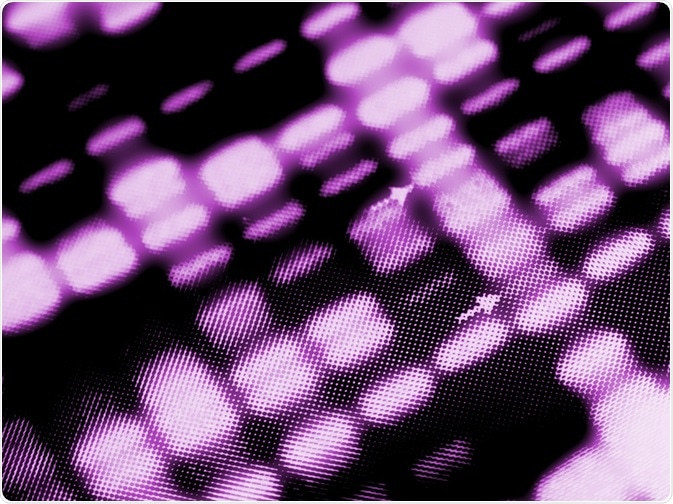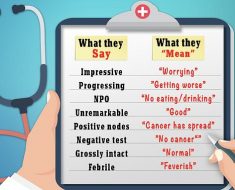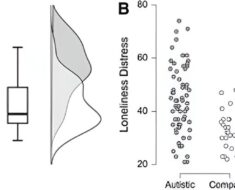Blotting is the process by which DNA, RNA or proteins are transferred onto a membrane in order to be visualised.
 Credit: Paul Cowan/Shutterstock.com
Credit: Paul Cowan/Shutterstock.com
The first of these methods was Southern Blotting, developed in 1975 by Edward Southern, and is used to detect the sequence of DNA fragments. Since then, two other methods have been developed, called Northern and Western blotting. These are processes which are used to identify RNA and protein sequences, respectively.
Methodology of Southern blotting
DNA fragments are initially generated with restriction enzymes and separated by size in a process called gel electrophoresis. Alkaline is then used to denature the doubled-stranded DNA, forming single strands. The DNA is then transferred onto a nitrocellulose or nylon sheet by placing a membrane over the gel and using the flow of buffer to encourage the movement of DNA from the gel to the membrane.
Capillary flow and vacuum transfer are the two most common methods used to transfer the DNA fragments. In capillary flow, the gel is placed above the level of buffer on a supporting block with a membrane placed on top. A stack of absorbent towels are then placed over the membrane and are used to absorb the buffer from beneath the gel, lifting the DNA fragments up onto the membrane.
Using vacuum transfer, the membrane is placed beneath the gel and both are submerged in buffer. A vacuum is then used to create a flow which pull the DNA fragments down onto the membrane.
Heating or UV radiation are then used to ensure that the DNA fragments remain attached to the membrane permanently, whilst maintaining the specific arrangement of DNA. Single-stranded labelled probes are then used to bind to target sequences.
The sheet is incubated with these probes and only the complementary probes bind. The non-complementary probes are then washed from the membrane, ensuring that only the bound probes remain. These probes can then be detected by autoradiography to reveal the pattern of hybridisation on an x-ray film.
Applications of Southern blotting
Southern blotting has many different uses. Firstly, gene rearrangements can be analysed. For example, in immunology this method can be used to identify the clonal rearrangements of T cell receptor genes. Secondly, specific fragments of DNA can be identified from within a mixture of many other fragments.
Other examples of uses include both restriction fragment length polymorphism (RFLP) and variable number tandem repeat (VNTR) analysis. RFLP uses the differences in length in homologous DNA sequences to map genomes, and can be used in forensic and paternity tests.
VNTR analysis uses the differences in length of repeated nucleotide sequences to form a DNA fingerprint, a method that is commonly used in paternity and forensic testing.
These methods can also be used in the diagnosis of disease caused by mutation, for example sickle cell anaemia. This genetic condition is due to a single nucleotide polymorphism (A to T) in the beta-globin gene, resulting in abnormal haemoglobin.
Southern blotting for Fragile X syndrome
Southern blots have been used extensively to help identify genes with amplified repeat regions. These are short, repetitive sequences in DNA that do not encode gene products. One example where southern blotting can be useful is in the diagnosis of Fragile X syndrome. This genetic condition is due to the increase in the CGG/CCG repeat region which is located within the FMR1 gene.
This gene usually contains between 5-40 repeat regions. Individuals with 55-200 repeats have a FMR1 gene premutation, and individuals with >200 repeats have fragile X syndrome. The increase in repeats leads to methylation of the gene, which inhibits transcription and prevents the production of the FMRP protein. This protein is required for the normal function of the nervous system, therefore loss of protein function leads to the symptoms of fragile X syndrome.
In diagnosis, methylation-sensitive restriction enzyme EclX1 and Methylation-insensitive enzyme EcoR1 are used to allow the differentiation of methylated alleles and non-methylated alleles. Methylated alleles are cut only once to give a singular DNA fragment of 5.1 kb.
However non-methylated alleles are cut twice, producing a fragment of 2.8 kb. Non-methylated premutation repeats (<200) can therefore be distinguished from methylated mutation repeats of around 200 repeats long, as southern blotting can be used to identify the sizes of the DNA fragments.
Future perspectives
Overall, Southern blotting is an important method in the diagnosis and study of disease (such as fragile X syndrome and sickle cell anaemia) and analysis of DNA for other reasons (such as forensic and paternity testing).
However, southern blotting is very technically complex, expensive, laborious and requires a large quantity of DNA sample. New methods are therefore slowly replacing southern blotting, for example real time PCR. This process is much easier and faster than southern blotting and only requires a very small volume of DNA.
Sources:
- http://bioinfosu.okstate.edu/MG/MGW4/MG423.html
- https://www.genome.gov/glossary/index.cfm?id=459
- www.cambridge.org/…/S0029665196000912
- https://link.springer.com/protocol/10.1007%2F978-1-60761-947-5_19
- www.nationaldiagnostics.com/…/overview-northern-and-southern-blotting
- www.cpet.ufl.edu/…/Southern-Blot-Handout-2011.pdf
- https://ghr.nlm.nih.gov/condition/fragile-x-syndrome#diagnosis
- Sofocleous, C. et al (2009) ‘Molecular diagnosis of fragile X syndrome’, Expert Review of Molecular Diagnostics, 9(1), pp. 23–30. doi: 10.1586/14737159.9.1.23.
- Wattendorf, D.J. and Muenke, M. (2005) ‘Diagnosis and management of fragile X syndrome’, American Family Physician, 72(01), pp. 111–113.
Further Reading
- All Genetics Content
- What is Genetics?
- History of Genetics
- Genetics and Gene Expression
- Genetic Change
Last Updated: Feb 26, 2019

Written by
Hannah Simmons
Hannah is a medical and life sciences writer with a Master of Science (M.Sc.) degree from Lancaster University, UK. Before becoming a writer, Hannah's research focussed on the discovery of biomarkers for Alzheimer's and Parkinson's disease. She also worked to further elucidate the biological pathways involved in these diseases. Outside of her work, Hannah enjoys swimming, taking her dog for a walk and travelling the world.
Source: Read Full Article




